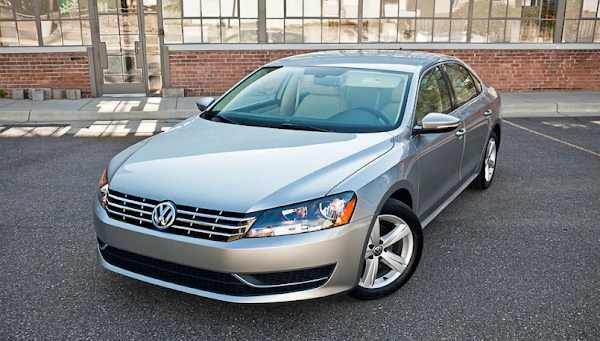
The 2012 Passat: It is the second of Volkswagen's new "Americanized" cars and the first to come from its all-new factory in Chattanooga, Tennessee. The new plant seems up to snuff in the initial-quality department, with panels all screwed together well and with reasonably tight panel gaps. I say "reasonably" because Fisher Price-grade plastics can fit together only so tightly. While the cabin may be attractively designed, there are few soft-touch plastics to be found and too many that are reminiscent of the little red-and-yellow buggy many of us had as children.
If the Passat were the price-leader in the segment, the low-rent interior might be more understandable. Volkswagen likes to tout the low-low price of $19,995 (before destination), but our automatic-equipped 2.5 SE came in at $25,595 with destination. That the price tag sits mid-pack. Both the Hyundai and the Kia as well as the Mazda6 sticker for less; the Toyota Camry and the Honda Accord are within a few hundred dollars; and the Subaru Legacy and Ford Fusion are the most expensive.
 The Passat does, however, have a clean, slick exterior design and is engaging to drive -- two major points in its favor. I was able to drive my neighbor's current-generation Accord back-to-back with this Passat; we both agreed that the Passat looked better (and bigger) and its well-weighted steering and peppy five-cylinder made it much more enjoyable behind the wheel; its downsides were touchy brakes and a sub-par interior. The neighbor's final verdict was that it was more appealing, but he wouldn't buy one given VW's spotty quality history.
The Passat does, however, have a clean, slick exterior design and is engaging to drive -- two major points in its favor. I was able to drive my neighbor's current-generation Accord back-to-back with this Passat; we both agreed that the Passat looked better (and bigger) and its well-weighted steering and peppy five-cylinder made it much more enjoyable behind the wheel; its downsides were touchy brakes and a sub-par interior. The neighbor's final verdict was that it was more appealing, but he wouldn't buy one given VW's spotty quality history.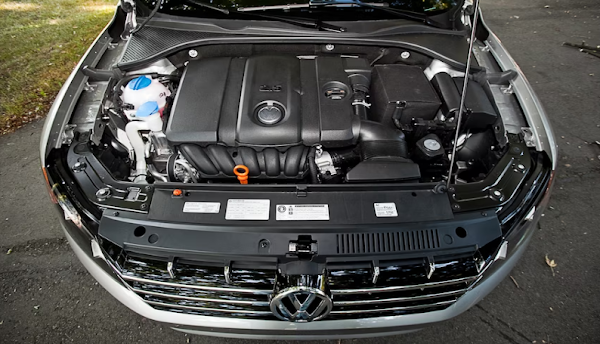
I have to admit that when I first saw this car at the 2011 Detroit Auto Show, I did not like it. I wondered how could VW create something so beautiful and fun to drive as the CC, and then launch this version of a Passat? I still think CC is what Passat should have evolved to, but VW has its market ambitions.
The keys arrived Friday. I was off for a Passat experience weekend. It appeared that this was the base model, as extras seemed to be few and far between. There was not even air vents for rear passengers. So far it was living up to my low expectations.
Fast forward to Sunday evening. I'd taken the trash out and when walking back looking at the car in the driveway, I thought... I actually like this car. It's a basic car, but with good bones. It needs a few things, as all cars do, but I grew to like it. The steering wheel felt great in the hands. It surprised me with the power that it had. Its lack of body roll set it apart from the Sonata and Camry. Fuel range was impressive, and there's loads of room for long-legged back seat drivers/passengers.
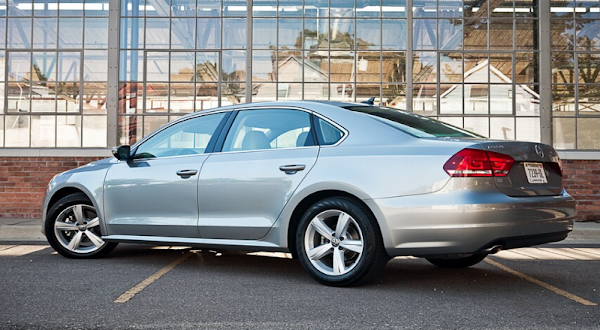
In chopping the Passat's price by some $7000 compared to the previous version, VW achieved its biggest cost savings not in the interior (which is still quite nice), or the chassis (which provides a decent ride), but in the powertrain. The base engine in the 2010 model was Volkswagen's highly regarded 2.0-liter turbo, which made a hearty 200 hp and 207 pound-feet of torque while still returning 22 mpg city and 31 mpg highway. Now we get the old 2.5-liter five out of the cheaper Jetta. Despite having one more cylinder, this is not an upgrade. The five musters only 170 hp and 177 pound-feet of torque, but despite the lower power output, fuel economy is about the same (21 mpg city, 33 mpg highway). In addition to being not particularly economical, the five-cylinder is coarse and not at all engaging, quite unlike the old 2.0T.
For buyers willing to spend more, better options exist: the fuel miserly TDI and the potent 3.6-liter V-6. As for the base car, things will get better. Word is that VW finally will be dumping the cheap-to-build but uninspiring five in favor of a direct-injected 1.8-liter turbo four. That will be a welcome change indeed for buyers of the standard Passat, and will eradicate the worst sacrifice exacted in the quest for greater affordability.
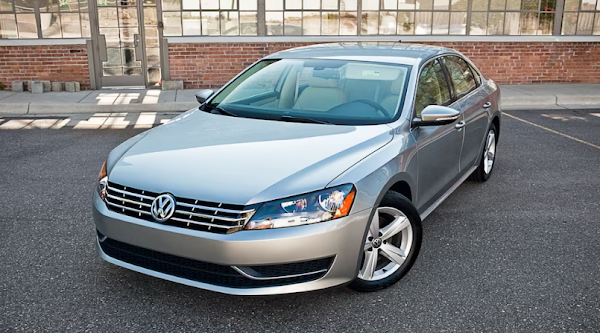
Like my colleagues, I'm skeptical of Volkswagen's plan to make its cars cheaper in both price and quality. Imagine the uproar if Apple announced plans to slash prices on its laptops by equipping them with 20-gigabyte hard drives and monochrome screens. However, the de-contented 2011 Jetta is selling far better than the 2010 Jetta, leading me to grudgingly admit VW may have found a winning formula for sales success.
If the 2012 Passat were your first Volkswagen -- and especially if you had previously driven a Toyota Camry or Honda Accord -- you would probably be very happy with it. But if you've ever driven another VW product, even a ten-year-old base Jetta, you'll notice the areas in which VW cut corners on this car. The trunk is no longer fully lined and lacks the hidden hinges of other VWs. The hood uses a cheap prop rod instead of gas struts. The interior materials aren't as soft or plush as in other models, like the Golf.
 I would have no problem driving a Passat 2.5SE, equipped just like our tester, as my daily driver. It drives well, looks reasonably nice, and has a positively enormous rear seat. But whereas other Volkswagen products feel special and intangibly nicer than their competitors, the Passat just feels like any other roomy mid-size sedan. The Passat is not a terrible car, but nor is it amazing in any way.
I would have no problem driving a Passat 2.5SE, equipped just like our tester, as my daily driver. It drives well, looks reasonably nice, and has a positively enormous rear seat. But whereas other Volkswagen products feel special and intangibly nicer than their competitors, the Passat just feels like any other roomy mid-size sedan. The Passat is not a terrible car, but nor is it amazing in any way. My colleagues in the auto journalist community bitched and brayed about the new Volkswagen Jetta for so long that by the time I had an opportunity to drive it, I was shocked that it wasn't the pile of you-know-what that many of them had made it out to be. Such was the case again with the Passat, which has been much maligned over the past six months for supposedly falling short of the highly regarded B5-series Passat that arrived here in 1998. So when I finally stepped into the 2012 Passat SE last night, imagine my surprise when I found a smooth, supple, refined, predictable, and relatively luxurious sedan. This new Passat is no B5, but it also costs significantly less in 2011 dollars. Yeah, the five-cylinder engine is a little noisy at full revs, but it's all the engine most Americans need or want, and it works well with the six-speed automatic. A V-6 is also available. More important than the power under the hood is the chassis, and this one is nicely tuned, providing a very creamy yet controlled ride and very good steering. I stormed along one of my favorite stretches of curvy road in the Passat and was quite pleased with its demeanor. It felt appreciably different from American and Asian competitors; it felt German.
My colleagues in the auto journalist community bitched and brayed about the new Volkswagen Jetta for so long that by the time I had an opportunity to drive it, I was shocked that it wasn't the pile of you-know-what that many of them had made it out to be. Such was the case again with the Passat, which has been much maligned over the past six months for supposedly falling short of the highly regarded B5-series Passat that arrived here in 1998. So when I finally stepped into the 2012 Passat SE last night, imagine my surprise when I found a smooth, supple, refined, predictable, and relatively luxurious sedan. This new Passat is no B5, but it also costs significantly less in 2011 dollars. Yeah, the five-cylinder engine is a little noisy at full revs, but it's all the engine most Americans need or want, and it works well with the six-speed automatic. A V-6 is also available. More important than the power under the hood is the chassis, and this one is nicely tuned, providing a very creamy yet controlled ride and very good steering. I stormed along one of my favorite stretches of curvy road in the Passat and was quite pleased with its demeanor. It felt appreciably different from American and Asian competitors; it felt German.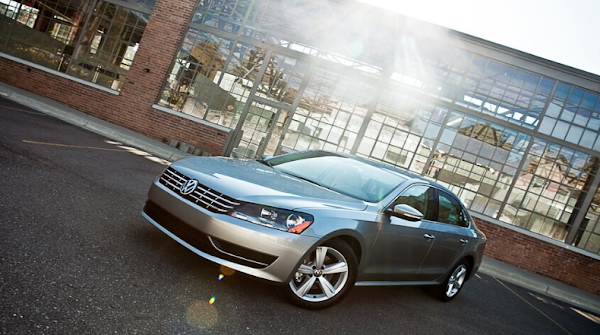 I cannot get over how huge the interior is. I'm five feet, eleven inches and I adjusted the front seat to a comfortable driving position and then moved to the rear seat directly behind, and there was a ton of legroom. There's plenty of space in this American-made sedan for big Americans.
I cannot get over how huge the interior is. I'm five feet, eleven inches and I adjusted the front seat to a comfortable driving position and then moved to the rear seat directly behind, and there was a ton of legroom. There's plenty of space in this American-made sedan for big Americans. I also did not mind the fake leather upholstery, and although the plastics are undeniably not as nice as they were in the B5 Passat, they are far from offensive and everything in the cabin is well put together. I like the shallow dash and the A-pillars, which aren't too thick, helping the sense of good forward visibility. Our tester had a bunch of blank buttons around the gearshift lever that I suppose are for options that our car didn't have, but we at least had Bluetooth and satellite radio.
I also did not mind the fake leather upholstery, and although the plastics are undeniably not as nice as they were in the B5 Passat, they are far from offensive and everything in the cabin is well put together. I like the shallow dash and the A-pillars, which aren't too thick, helping the sense of good forward visibility. Our tester had a bunch of blank buttons around the gearshift lever that I suppose are for options that our car didn't have, but we at least had Bluetooth and satellite radio.There are signs of cost-cutting, to be sure, but they're pretty subtle. Lift the hood and pull up the support pole, because there are no self-positioning struts. When you go to the other end of the car to access the large trunk, you might be a little disappointed, as I was, that the big chrome VW badge does not rotate inward to unlatch the trunk lid. Instead, there's a conventional rubber touch pad tucked up under the lid. The trunk has a low lift-over height and handles on the underside of the lid to easily pull it shut. Cost-cutting rears its head with the exposed support hinges; more expensively finished cars would tuck those behind the trunk trim so they don't squash your belongings.











